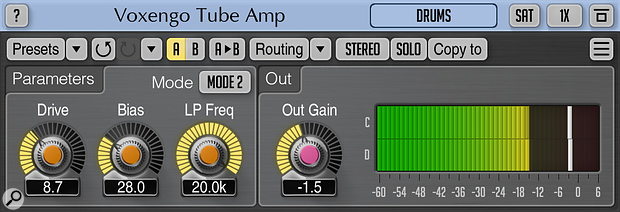How do you differentiate between the following terms: saturation, harmonics, distortion, overdrive? Are all of these just similar terms with different names? When should we use one of these versus the other? Is there a way to quantify or measure the addition of these signal enhancements other than just by their sound — perhaps with something like DDMF's Plugindoctor? Do you have any good references to recommend of songs to strive to emulate? How can you tell if you've over-baked your track and gone too far?
Pat Autrey
SOS contributor Mike Senior replies: Well, as regards the terminology, although some of those terms have agreed scientific definitions, in the real world of project-studio work all of them are actually used quite loosely. In the most general sense, distortion is the result of any process that alters a sound's waveform and therefore adds new frequency components. If these added frequencies are generated in harmonic relation to the source sound (as is the case when applying most analogue-style distortion effects), they're usually called harmonics. Saturation, overdrive and fuzz are all words used to describe 'flavours' of distortion — from saturation at the subtle end to fuzz at the extreme. In this context, you may also find the word 'distortion' used to imply a certain severity of distortion effect, usually somewhere between overdrive and fuzz. However, it's important to realise that many analogue-style saturation effects don't just add extra frequency components, but also affect the dynamic qualities of the sound, so in a sense saturation is only partly a distortion effect.
If all of this sounds a bit vague, that's because it is! And while there are indeed ways to measure and quantify the distortion and dynamics characteristics of different plug-ins technically, such measurements aren't of much practical use when it comes to learning how to get the best out of each effect in practice.
So what should the game-plan be with these effects at mixdown? Well, the crux of the matter is that distortion is seldom applied for technical reasons — it's usually a means of adjusting the subjective timbre of the sound — so it stands to reason that everyone will have their own opinion on what sounds good, depending on the kinds of productions they admire. I can't dictate what a 'good' reference track is as far as you're concerned, because different people like music with different types and amounts of distortion in it, and different artists and genres also differ widely in this respect. You have to choose reference tracks that suit you and the music you're working on. Once you've done that, it's comparing your mix against those references that'll let you know whether you're 'over-baking' them with distortion.
The problem with a totally 'suck it and see' approach to choosing distortion effects is that trial and error can be very time-consuming. This is where some understanding of the nature of different distortion effects can be useful. For instance, once you've used a couple of different tube saturators or tape emulators, you'll begin to get a feel for the kinds of sounds they produce, so whenever you're faced with a new plug-in based on tubes or tape you'll already have a rough idea of what it's likely to do even before you try it out. In a similar vein, if you're looking to expand the range of distortion flavours available to you, it makes sense to seek out distortion devices with unfamiliar designs. After a while, you'll build up a small library of plug-ins that will provide you with a wide variety of distortion timbres, and you'll have developed an idea of which plug-ins are most likely to help you in which situations.
For example, for mixing purposes I've come to regularly use Voxengo's Tube Amp, Klanghelm's IVGI, GVST's GClip & GRect, Mokafix's NoAmp, ToneBoosters' ReelBus, Sonimus' Britson & Satson, and various stompbox and guitar-amp simulators in IK Multimedia's Amplitube. Over time I've developed a mental image of the kinds of sounds each of those plug-ins can create, and what those sounds have been useful for, so I can usually make a decent educated guess about which to use for any given mix scenario — which speeds up my workflow. Mind you, on occasion none of these plug-ins end up being suitable, in which case it's back to the trial and error to find some new options! It's never wasted time, though, because every new processor you experiment with increases your experience and listening skills.
Published August 2019

No comments:
Post a Comment